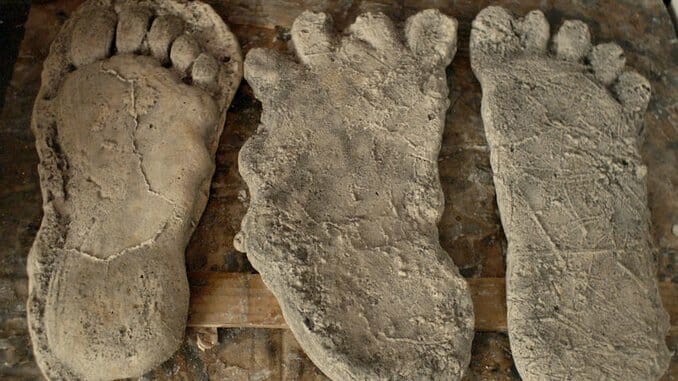Hulu’s Sasquatch Wishes Its Mystery Could Match the Beast in Its Title
Photos Courtesy of Hulu
It’s hard to blame a director, or group of producers, for having their interest piqued when tantalized with an interesting or bizarre synopsis for a prospective docuseries. Who among us, hearing something like “an investigation into a grisly triple murder rumored to have been committed by Bigfoot,” doesn’t want to hear a bit more about such a ludicrous premise? Compelling stories have been fashioned out of far less salacious, far less interesting leads than “killer sasquatch on the loose.” But at the end of the day, a documentary often must be judged by what kind of story it’s able to uncover via reporting and investigation. And that, sadly, is where Hulu’s new docuseries Sasquatch completely fails to fill the footprints of its mythical title character. Simultaneously an exploitative quasi-doc on cryptozoology and a lukewarm true crime investigation into murders it can’t actually prove ever occurred, Sasquatch takes on the guise of so many other hoaxsters: A man in a costume, trying to convince you something extraordinary has occurred.
Sasquatch is directed by Joshua Rofé, who produced and directed Amazon’s Lorena Bobbitt docuseries Lorena, and produced by the Duplass brothers, who have also produced the likes of Netflix’s Wild Wild Country and HBO’s recent The Lady and the Dale. It joins recent Hulu documentaries such as the streamer’s recent look into WeWork, and Soleil Moon Frye’s Kid 90, but the true ethos of Sasquatch revolves entirely around its on-screen guide: David Holthouse.
Holthouse is a journalist, of the sort who would likely be proud to be labeled “muckraker”—rough around the edges, comfortable in the presence of thieves and conmen, and always searching for a story to tell. Professionally, he’s likely best known for a disturbing personal essay he wrote in Denver’s Westword in 2004, entitled “Stalking the Bogeyman,” in which Holthouse details his plans to stalk and kill the man who raped him years earlier, when he was only 7. Suffice to say, he decides not to go through with the vengeance killing, and has instead spent the last few decades writing stories that often involve embedding himself in various corners of the criminal underworld, infiltrating groups such as neo-Nazis, street gangs, drug dealers and others in order to write first-person accounts for we normies on the outside. The entire set-up for Sasquatch depends on one of these types of stories, culled from an incident that is now almost 30 years old.
In 1993, Holthouse was visiting a friend, working on a pot farm in a remote part of the “Emerald Triangle” in California’s Mendocino County—so named because it’s the biggest cannabis-producing region in the USA. One dark and stormy night, their camp was visited by an agitated meth addict who excitedly told a story that Holthouse says he overheard. The story: That the tweaker had just come from another pot farm in the area where three Mexican laborers had been savagely torn to bits, apparently by an enraged sasquatch. The crime was never reported, and Holthouse and others present at the time understood that for their own protection they would be expected to stay quiet about it.
Some 25 years later, Holthouse is an investigative reporter who suddenly decides to start looking back into that story he heard in 1993, and this is the basis of Sasquatch—a man investigating a story he heard many years earlier, about which he apparently never had any particular curiosity until now. How convenient that he suddenly redeveloped a burning interest in sasquatch murder at the same time that a documentary crew wanted to film it, right? Holthouse explains his mission as follows: “Maybe someone got away with murder, and I can find out who, and how, and why.” Except no, when all is said and done, he doesn’t particularly do any of these things.
It eventually becomes clear that neither Rofé, nor Holthouse, have any particular belief in the legendary cryptid known as bigfoot—they’re just willing to pretend that they do for 90% of the runtime, if it means they can trick gullible sasquatch true believers (the most obvious viewer demo) into watching the series they’ve produced. To this effect, the entire first episode of Sasquatch functions more or less like an earnest bigfoot documentary, interviewing various luminaries of the field such as Dr. Jeffrey Meldrum, who also appeared in History Channel’s shamefully terrible (and completely fake) Bigfoot Captured back in 2015. This mode of inquiry reaches its nadir with the inclusion of James “Bobo” Fay, a literal cast member/charlatan of Animal Planet’s Finding Bigfoot, who is presented as merely a sasquatch hunter/enthusiast rather than a TV personality who has made 9 seasons, 100 episodes, and a boatload of money out of failing to bring a show’s title to fruition. In almost a decade to date, the total number of bigfeet “found” on Finding Bigfoot is still firmly in the “zero” camp.
 You can’t have a guy like this in your documentary without at least acknowledging that he’s made an entire career out of failing to find bigfoot on TV.
You can’t have a guy like this in your documentary without at least acknowledging that he’s made an entire career out of failing to find bigfoot on TV.
-

-

-

-

-

-

-

-

-

-

-

-

-

-

-

-

-

-

-

-

-

-

-

-

-

-

-

-

-

-

-

-

-

-

-

-

-

-

-

-

 Holthouse portrays himself as a hunter of human monsters, but doesn’t have much to show for it in 140 minutes of docuseries footage.
Holthouse portrays himself as a hunter of human monsters, but doesn’t have much to show for it in 140 minutes of docuseries footage.






































